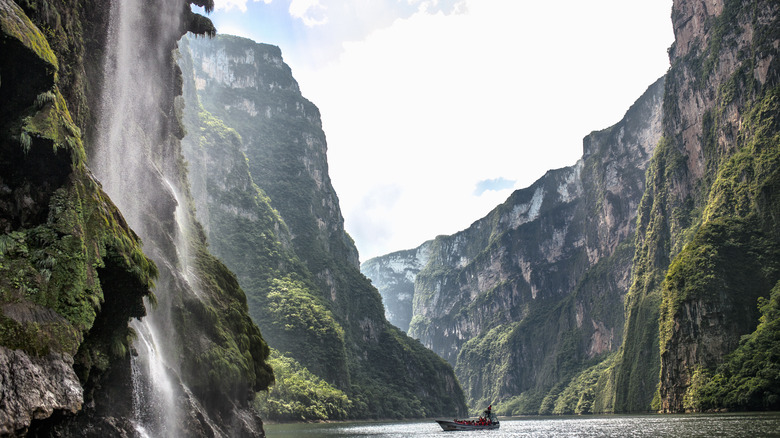Some Of Mexico's Best Natural Wonders Are Hidden In The Jungles Of A Lesser-Visited Southern State
Mexico boasts some truly exquisite scenery. From the deep, dramatic cliffs and valleys of the Copper Canyons in Chihuahua and the stunning petrified waterfalls of Hierve el Agua in Oaxaca to the breathtaking migrations of Monarch butterflies and the vibrant pink lagoons of Las Coloradas, it is a country full of stunning natural beauty. But while plenty of its amazing landscapes are well-known — even world-famous — some of the best and most impressive natural wonders are bizarrely overlooked, hidden away in the jungles of its southernmost state.
Chiapas is one of the least visited and least known destinations in Mexico. Tucked up against the border of Guatemala in the far southwest, it doesn't have the breathtaking white sand beaches or exciting cultural cities that are often the stereotypical image of Mexico. But what it lacks in tropical paradise vibes, it more than makes up for in jaw-dropping natural beauty and under-the-radar authenticity. It is a diverse, varied state that is well off the beaten track, making it a magical and mysterious place for adventurous travelers to explore.
While the main airport —Angel Albino Corzo International Airport — is near the state capital, Tuxtla Gutierrez, most visitors to Chiapas use the beautiful hill town of San Cristobal de las Casas as a base. This charming colonial spot is a fabulous destination in its own right, but it also sits roughly in the middle of the state, making it ideal for planning day trips out into the backcountry of southern Mexico.
Dramatic cascades, chilly pine forests, and untouched beaches
One of the best things about the landscape of Chiapas is how incredibly varied it is. From cold, misty, mountainous pine forests and steaming coastal jungles to towering cascades and deep ravines, there are so many different things to see. A great place to start is the Reserva de la Biosfera Selva El Ocote, about two and a half hours away from San Cristobal de las Casas. Spanning La Venta River, this incredible protected area is full of highland forests and karstic caverns. It also boasts some of the most interesting and rare bird species in Mexico, making it a haven for birdwatchers.
Chiapas is also packed with some incredible waterfalls. The best-known are the Cascadas Agua Azul (about a four-hour drive from San Cristobal) and the Cascadas El Chiflon (a three-hour trip). But you don't have to travel that far to find impressive cascades, with Cascada El Chorreadero and Cascada Paraiso Escondido both just outside Tuxtla Gutierrez.
While not on the same level as the beaches of the Mexican Caribbean, Chiapas has an extensive coastline with a selection of pristine sandbar beaches, which, if you are lucky, you'll have all to yourself. Backed by mangrove swamps and lagoons filled with wildlife, Playa Puerto Arista is a great spot for surfing and waterskiing thanks to its strong waves, while Playa Azul offers calmer vibes, perfect for relaxation. Finally, Playa Zacapulco is part of La Encrucijada Biosphere Reserve, with over 90 bird species and several turtle nesting spots, making it ideal for wildlife lovers.
Mexico's Grand Canyon and the biosphere of 59 lakes
Chiapas's most spectacular and eye-catching natural wonder is the Cañon del Sumidero, Mexico's answer to the Grand Canyon. This stunning fissure drives through the Sumidero Canyon National Park, with the fast-flowing Río Grijalva running along the bottom of the ravine. With towering walls reaching up to 3,300 feet from the river, a boat trip serves up prehistoric "Jurassic Park" vibes, with echoes of the limestone karsts of Vietnam's Ha Long Bay or the dramatic fjords of Norway. Regular boat tours of the canyon run from Chiapa del Corzo, one of the best magic towns in Mexico, about an hour from San Cristobal de las Casas.
Another natural gem of Chiapas is the Parque Nacional Lagunas de Montebello, right up against the border of Guatemala. This beautiful series of crystal-clear lakes was designated the first national park of Chiapas in 1959, and a Biosphere Reserve by UNESCO in 2009. Its 59 lakes are famous for their vivid, dramatic colors, ranging from bright green and azure blue to purple, red, and even pitch black! Many of the lakes are open for swimming and canoeing, and visitors can also explore the rest of the park, with its limestone caverns and underwater river caves known as cenotes.


